Australia is seeking to increase mango exports to Japan following the recent removal of restrictions on the varieties of the fruit that can be shipped to a market it sees as having growth potential.
Australia wants to take advantage of its mango season, which is different from that of rival producers in the opposite hemisphere.
The country exports about 10% of about 70,000 tons of mangoes it produces annually. Major export destinations are New Zealand, Singapore and China, including Hong Kong.
Australia's exports to Japan began in the 1990s. Due to concerns over insect pests, however, Japan accepted only five types, including the less risky Kensington variety.
But this year, Japan removed its restrictions to accept all varieties, saying that vapor heat treatment in accordance with international standards makes it possible to slash pest risks.
The best season for Australian mangoes is from November to February, which falls within summer in the Southern Hemisphere country. During the season, Australian mangoes have an advantage over mangoes produced in Northern Hemisphere countries such as Japan, Southeast Asian nations and Mexico.
Also, mango varieties popular in Australia, such as the red-skinned Calypso and the golden Honey Gold, are likely to become available in Japan after the removal of the varietal restrictions.
"Japan is a priority market for Australian horticulture," Australian agriculture minister Murray Watt said. "The removal of varietal restrictions makes way for changes for other commodities, potentially paving the way for further market access expansions and strengthening the Australian horticultural sector."




